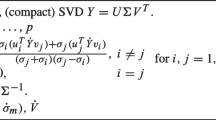Abstract
In this paper, we extend the framework describing the probabilistic evolution of explicit unidimensional ODEs, which is described in the companion of this paper, to multidimensional cases. We show that an infinite set of linear ODEs accompanied by an initial condition (represented with an infinite vector) can also be constructed for the multidimensional cases. The principles that underly the construction of the equations and the truncated approximants of the solutions are the same. The crucial addition of this paper is the use of multiindex, folded and unfolded vectors and matrices. Unlike our earlier work on folded arrays, which relied on probabilistic principles of construction, in this work, we use a purely mathematical approach for the construction of the multidimensional structures. We provide a procedural description of how such constructions can be made.
Similar content being viewed by others
References
M. Demiralp, E. Demiralp. A contemporary linear representation theory for ordinary differential equations: probabilistic evolutions and related approximants for one dimensional case. J. Math. Chem. (2012). doi:10.1007/s10910-012-0070-2
M. Demiralp, E. Demiralp, L. Hernandez-Garcia. A probabilistic foundation for dynamical systems: theoretical background and mathematical formulation. J. Math. Chem. (2012). doi:10.1007/s10910-011-9929-x
M. Demiralp, E. Demiralp, L. Hernandez-Garcia. A probabilistic foundation for dynamical systems: phenomenological reasoning and principal characteristics of probabilistic evolution. J. Math. Chem. (2012). doi:10.1007/s10910-011-9930-4
E. Demiralp, M. Demiralp. Dynamical causal modeling from a quantum dynamical perspective, in AIP Proceedings for the International Conference of Numerical Analysis and Applied Mathematics (ICNAAM 2010), Symposium 112, Recent Developments in Hilbert Space Tools and Methodology for Scientific Computing, vol 1281 (Rhodes, Greece, 2010), pp. 1954–1959 (19–26 Sept 2010)
Demiralp M., Rabitz H.: Lie algebraic factorization of multivariable evolution operators: definition and the solution of the canonical problem. Int. J. Eng. Sci. 31, 307–331 (1993)
Demiralp M., Rabitz H.: Lie algebraic factorization of multivariable evolution operators: convergence theorems for the canonical case. Int. J. Eng. Sci. 37, 333–346 (1993)
Marcus M.: Finite Dimensional Multilinear Algebra. Dekker, New York (1975)
Kruskal J.B.: Three-way arrays: rank and uniqueness of trilinear decompositions with applications to arithmetic complexity and statistics. Linear Algebra Appl. 18, 95–138 (1977)
J.B. Kruskal, in Rank, Decomposition, and Uniqueness for 3-way and N-way Arrays, Multiway Data Analysis, ed. by R. Coppi, S. Bolasco (North-Holland, 1989), pp. 7–18
Leurgans S.E., Ross R.T., R.B. Abel: A decomposition for three-way arrays. SIAM J. Matrix Anal. Appl. 14, 1064–1083 (1993)
De Lathauwer L., De Moor B., Vandewalle J.: A multilinear singular value decomposition. SIAM J. Matrix Anal. Appl. 21(4), 1253–1278 (2000)
Zhang T., Golub G.H.: Rank-one approximation to high order tensors. SIAM J. Matrix. Anal. Appl. 23(2), 534–550 (2001)
Kolda T.G., Bader B.W.: Tensor decompositions and applications. SIAM Rev. 51(3), 455–500 (2008)
Andersen A.H., Rayens W.S.: Structure-seeking multilinear methods for the analysis of fMRI data. NeuroImage 22, 728–739 (2004)
Andersen C.M., Bro R.: Practical aspects of PARAFAC modeling of fluorescence excitation-emission data. J. Chemom. 17, 200–215 (2003)
Beckmann C., Smith S.: Tensorial extensions of independent compo nent analysis for multisubject FMRI analysis. NeuroImage 25, 294–311 (2005)
Beckmann C., Smith S.: Review on multiway analysis in chemistry 2000–2005. Crit. Rev. Anal. Chem. 36, 279–293 (2006)
Comon P.: Independent component analysis, a new concept?. Signal Process. 36, 287–314 (1994)
P. Comon, Tensor decompositions: state of the art and applications, in Mathematics in Signal Processing V, ed. by J.G. McWhirter, I.K. Proudler (Oxford University Press, Oxford, 2001)
R. Coppi, S. Bolasco (eds.), Multiway Data Analysis (North-Holland, Amsterdam, 1989)
De Lathauwer L., De Moor B., Vandewalle J.: Independent component analysis and (simultaneous) third-order tensor diagonalization. IEEE Trans. Signal Process. 49, 2262–2271 (2001)
Kolda T.G.: Orthogonal tensor decompositions. SIAM J. Matrix Anal. Appl. 23, 243–255 (2001)
Kolda T.G.: A counterexample to the possibility of an extension of the Eckart-Young low-rank approximation theorem for the orthogonal rank tensor decomposition. SIAM J. Matrix Anal. Appl. 24, 762–767 (2003)
E. Demiralp, M. Demiralp, Reductive multilinear array decomposition based support functions in enhanced multivariance product representation (EMPR), in Proceedings for the 1st IEEEAM Conference on Applied Computer Science (ACS), 15–17 September 2010 (Malta, 2010), pp. 448–454
M. Demiralp, E. Demiralp, An orthonormal decomposition method for multidimensional matrices, in AIP Proceedings for the International Conference of Numerical Analysis and Applied Mathematics (ICNAAM 2009), 18–22 September 2009, vol 1168 (Rethymno, Crete, Greece, 2009) pp. 428–431
Demiralp E.: Applications of high dimensional model representations to computer vision. WSEAS Trans. Math. 8(4), 184–192 (2009)
E. Demiralp, Applications of flexibly initialized high dimensional model representation in computer vision, in Proceedings for the WSEAS International Conference on Simulation, Modelling and Optimization (SMO’09), 3–5 September 2009 (Budapest, Hungary, 2009), pp. 310–315
E. Demiralp, Application of reductive decomposition method for multilinear arrays (RDMMA) to animations, in Proceedings of the 11th WSEAS international conference on Mathematical methods and computational techniques in electrical engineering (MMACTEE’09), pp. 648–656 (2009)
Author information
Authors and Affiliations
Corresponding author
Rights and permissions
About this article
Cite this article
Demiralp, M., Demiralp, E. A contemporary linear representation theory for ordinary differential equations: multilinear algebra in folded arrays (folarrs) perspective and its use in multidimensional case. J Math Chem 51, 38–57 (2013). https://doi.org/10.1007/s10910-012-0064-0
Received:
Accepted:
Published:
Issue Date:
DOI: https://doi.org/10.1007/s10910-012-0064-0




